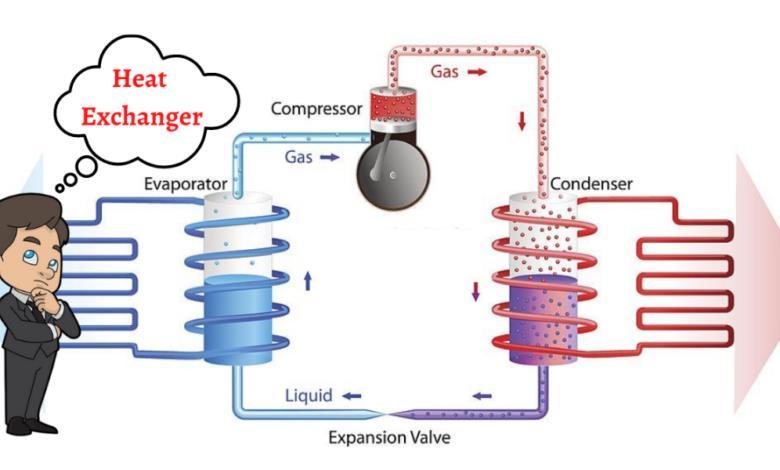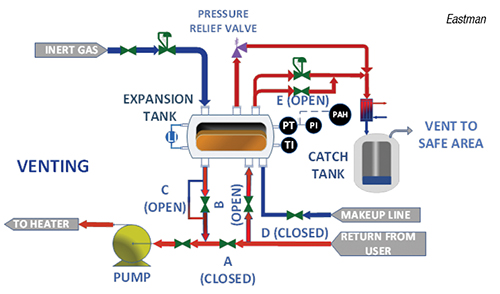Top Trends Shaping the Future of DVS Heat Transfer Systems
Wiki Article
A Comprehensive Overview to Selecting the Right Heat Transfer Solutions for Your Needs
Choosing the proper Heat transfer system is vital for functional effectiveness. Different systems deal with various requirements, affected by elements such as temperature array and liquid kind. Recognizing the principles behind Heat transfer, such as convection, radiation, and transmission, is important. Additionally, reviewing power sources and upkeep methods can affect lasting efficiency. A closer evaluation of these factors to consider reveals just how to customize a system to specific demands. What should one prioritize in this complex decision-making process?Comprehending Heat Transfer: Trick Concepts and Concepts
Heat transfer may appear like an uncomplicated concept, it encompasses a variety of principles that are essential for efficient system style - DVS Heat Transfer Systems. Comprehending these concepts is vital for developers and designers that intend to maximize thermal efficiency in various applications. Transmission, as an example, involves the transfer of Heat via solid materials, while convection refers to the movement of Heat within liquids. Radiation, an additional essential concept, defines just how Heat can be moved through electromagnetic waves. Each of these systems plays a crucial role in figuring out just how power relocates within a system. By completely understanding these principles, professionals can make informed decisions, making certain that Heat transfer systems run successfully and satisfy the particular needs of their applications
Types of Heat Transfer Equipments: A Review
Comprehending the principles of Heat transfer prepares for discovering the numerous kinds of Heat transfer systems readily available. Heat transfer systems can be classified mainly into three types: transmission, convection, and radiation. Transmission includes Heat transfer via solid products, relying upon direct contact in between bits. Convection, on the other hand, takes place in fluids (gases and liquids) where the motion of the fluid itself helps with Heat transfer. Radiation entails the transfer of Heat through electro-magnetic waves and does not call for a medium, enabling it to occur in a vacuum. Each sort of system has distinctive features and applications, making it crucial for individuals and organizations to thoroughly assess their certain needs when picking one of the most appropriate Heat transfer solution.Applications of Heat Transfer Equipments in Different Industries
Heat transfer systems play a crucial function across various industries, impacting efficiency and product top quality. In industrial manufacturing procedures, they help with exact temperature control, while in food and drink handling, they assure safety and security and preservation. Additionally, HVAC and climate control systems rely greatly on reliable Heat transfer to maintain comfortable environments.Industrial Production Processes

Many industrial production procedures rely heavily on effective Heat transfer systems to take full advantage of performance and enhance product high quality. In fields such as metalworking, Heat exchangers play an important function in keeping suitable temperature levels throughout welding, spreading, and building. These systems assure uniform Heat distribution, which is crucial for accomplishing desired material properties. Similarly, in the chemical manufacturing sector, Heat transfer systems assist in accurate temperature level control during responses, affecting yield and security. In textile production, effective Heat administration is crucial for dyeing and finishing procedures, influencing color uniformity and material quality. By selecting suitable Heat transfer modern technologies, makers can improve energy effectiveness and minimize functional expenses, ultimately leading to an extra sustainable and affordable manufacturing environment.
Food and Drink Handling
Reliable Heat transfer systems are equally important in the food and beverage handling market, where keeping ideal temperature levels is important for food safety and high quality. These systems play a crucial duty in processes such as pasteurization, food preparation, and sterilization, making certain that items are risk-free for intake and maintain their dietary value. Heat exchangers, for example, efficiently transfer Heat in between fluids, maximizing energy use while decreasing temperature changes. Additionally, refrigeration systems are fundamental for expanding and preserving disposable items service life. The option of Heat transfer modern technology directly influences functional performance and item integrity, making it imperative for food and beverage producers to choose the ideal systems customized to their specific handling requirements. This mindful option ultimately contributes to consumer contentment and food security.
Cooling And Heating and Environment Control
While many markets depend on Heat transfer systems for efficiency, COOLING AND HEATING (Home Heating, Air Flow, and Cooling) plays an essential function in keeping interior climate control across numerous settings. These systems utilize Heat transfer principles to manage temperature level, air, and moisture top quality, making certain comfort and safety and security in property, business, and commercial atmospheres. Correctly created cooling and heating systems enhance energy effectiveness, decrease functional costs, and reduce environmental check that effect. In business structures, as an example, reliable environment control adds to employee productivity and consumer complete satisfaction. In industrial applications, cooling and heating systems help maintain ideal conditions for equipment operation and item preservation. Choosing the right Heat transfer system is important for conference specific climate control demands and accomplishing total system performance.Reviewing Power Sources for Heat Transfer Systems
In assessing power resources for Heat transfer systems, a contrast of sustainable energy options and fossil gas factors to consider is vital. Sustainable sources, such as solar and wind, offer lasting options that can minimize environmental effect. On the other hand, fossil fuels remain widespread due to their recognized infrastructure and power thickness, triggering a cautious evaluation of both choices.Renewable Energy Options

Fossil Gas Factors To Consider
Evaluating fossil fuel factors to consider is essential for the efficiency and sustainability of Heat transfer systems. Nonrenewable fuel sources, such as all-natural gas, oil, and coal, are typical energy resources that offer significant Heat result, making them popular choices for residential and industrial applications. Their ecological effect, including greenhouse gas emissions and source depletion, elevates worries. When selecting a heat transfer system, it is essential to examine the accessibility, price, and regulative variables connected with these gas. In addition, the performance of fossil fuel systems have to be considered, as higher performance can minimize some ecological disadvantages. Inevitably, a balanced strategy evaluating efficiency and sustainability can lead decision-makers toward the most suitable Heat transfer remedy for their particular requirements.Variables to Think About When Picking a Warmth Transfer System
Picking a suitable Heat transfer system calls for cautious consideration of various variables that can significantly affect effectiveness and performance. One crucial aspect is the operating temperature level range, which dictates the materials and design suitable for the application. Furthermore, the sort of liquid made use of in the system-- whether gas or fluid-- influences Heat transfer performance and compatibility. The system's size and capability must align with the specific demands of the procedure to avoid ineffectiveness. Energy source accessibility is also vital, influencing operating expense and sustainability. The installment setting, including space restraints and access for upkeep, plays a substantial function in system option. Regulatory compliance and safety standards need to be thought about to assure the system fulfills all lawful needs.Maintenance and Effectiveness Optimization for Heat Transfer Systems
Keeping Heat transfer systems is important for guaranteeing maximum efficiency and longevity. Routine upkeep tasks, such as cleaning Heat exchangers and evaluating insulation, aid avoid click resources effectiveness losses due to fouling and thermal connecting. In addition, checking system criteria, consisting of pressure and temperature level, allows for very early discovery of anomalies, decreasing downtime and costly fixings. Implementing a precautionary upkeep schedule can enhance efficiency and extend the life expectancy of parts. Additionally, updating to advanced control systems can enhance operational performance by getting used to differing lots and conditions. By focusing on maintenance and effectiveness optimization, operators can accomplish minimized energy usage, lower functional expenses, and enhanced overall system dependability, eventually bring about much better source use and an extra lasting procedure.Future Patterns in Heat Transfer Technologies
As markets significantly prioritize sustainability and energy efficiency, future fads in Heat transfer technologies are established to undertake considerable changes. Developments such as sophisticated materials, consisting of carbon nanotubes and nanofluids, guarantee improved thermal conductivity and effectiveness. Furthermore, the integration of renewable energy sources into Heat transfer systems is getting momentum, advertising environment-friendly remedies. Smart modern technologies, consisting of IoT sensing units, are anticipated to reinvent tracking and control, making it possible for real-time information evaluation for maximized performance. The growth of modular and small systems will assist in less complicated installation and upkeep, providing to diverse applications. These advancements indicate a change towards even more sustainable, reliable, and adaptable Heat transfer solutions, aligning with global power goals and ecological requirements.
Often Asked Questions
What Are the Ecological Impacts of Heat Transfer Equipments?
The ecological influences of Heat transfer systems can include greenhouse gas emissions, power usage, and potential thermal pollution. In addition, improper disposal of materials and inadequacies can add to resource depletion and community disruption.Exactly how Do I Determine the Cost-Effectiveness of a Heat Transfer System?
To determine the cost-effectiveness of a warm transfer system, one must analyze initial costs, operational costs, upkeep needs, and energy performance, comparing these elements versus the anticipated life expectancy and performance of the system.Can Heat Transfer Systems Be Made Use Of in Residential Settings?
Heat transfer systems can without a doubt be utilized in household setups. They offer reliable home heating and cooling down services, making homes more comfortable while potentially reducing energy prices. Their versatility permits various applications in residential atmospheres.What Safety Rules Relate To Heat Transfer Solutions?
Safety policies for Heat transfer systems see it here generally consist of guidelines on installation, maintenance, and operation. Conformity with local building regulations, producer specifications, and market requirements is important to ensure efficient and safe system efficiency in numerous applications.Exactly How Do Different Materials Affect Heat Transfer Performance?

Conduction, for instance, entails the transfer of Heat via strong products, while convection refers to the movement of Heat within fluids. Understanding the concepts of Heat transfer lays the groundwork for discovering the various kinds of Heat transfer systems offered. Heat exchangers, for instance, successfully transfer Heat in between fluids, enhancing power use while reducing temperature fluctuations. In evaluating power sources for Heat transfer systems, a contrast of sustainable energy options and fossil fuel considerations is vital. Steels, such as copper and light weight aluminum, conduct Heat efficiently, whereas insulators like rubber and glass slow down Heat circulation.
Report this wiki page